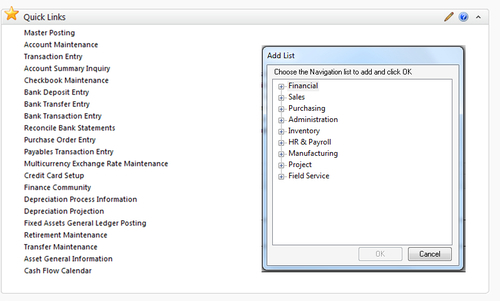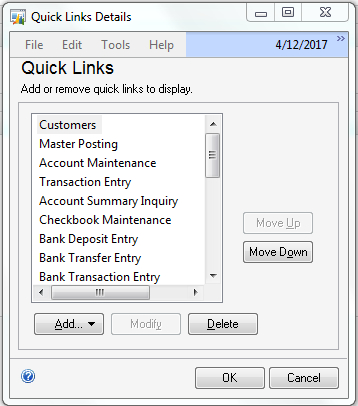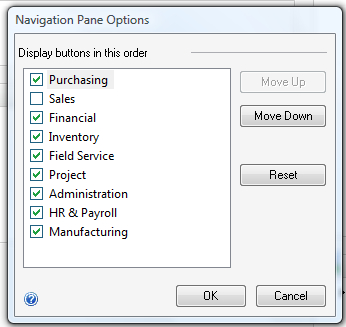Speeding up access to data with Quick Links
Like the Shortcut Bar, Quick
Links provide fast access to data both inside and outside of Dynamics
GP. Though there is some overlap with shortcuts, Quick Links provide
some unique features. For starters, related Quick Links are provided
based on the user's Home page role. Additionally, Quick Links also
provide fast access to Navigation Lists, something that shortcuts can't
do. In this recipe, we'll select an included Navigation list and then
add it as a Quick Link.
Getting ready
Navigation Lists provide
another way to work with data in Dynamics GP, and these aren't available
to add to the Shortcut Bar. For our Quick Links example we will look at
adding a Navigation list as a Quick Link.
How to do it...
To add a Navigation list as a Quick Link:
1. Click on the Home button on the Navigation Pane to the left. On the main Home screen, find the section labeled Quick Links.
2. Place the cursor in the Quick Links section and a pencil icon will appear on the upper right-hand side. Click on the small pencil icon and select Add | Dynamics GP Navigation List:

3. Click on the plus (+) sign next to Sales to expand the list.
4. Click on the plus (+) sign next to Accounts and select Customers. Click on OK to finish.
5. In the open Quick Links Details box, find and select the Customers link. Click on the Move Up button repeatedly until Customers is at the top of the list and then click on OK:

How it works...
This process puts the Customers Quick Link at the top of the Quick Links area. Now, clicking on the Customers Quick Link will immediately open that Navigation list. Without this Quick Link a user would need to select Sales from the Home page and find the Customers
Quick Link every time they needed to add a customer. Simply selecting a
Quick Link is a much faster way to get deep into Dynamics GP.
Rearranging Navigation to make it easier
The Navigation Pane on
the left-hand side of Dynamics GP is full of useful functions. Sometimes
it is too full! For many users it's beneficial to rearrange items on
the Navigation Pane to better suit their role. We'll look at how to do
that in this recipe.
Getting ready
Most users quickly discover that left-clicking and dragging the separator above the Home
button on the left allows them to shrink and expand the space available
for Navigation Pane buttons. This expands the room for lists and
shortcuts above by transforming the large buttons into smaller, but less
intuitive, icons. However, there is so much more that can be done to
personalize the Navigation Pane.
How to do it...
Cleaning up the Navigation
Pane can provide faster and simpler navigation options. Let's see how by
completing the following steps:
1. On the Navigation Pane select Navigation Pane Options from the bottom-right corner of the pane.
2. In the Navigation Pane Options window select Purchasing and move it to the top using the Move Up button at the right.
3. Then select the Sales module and deselect its checkbox. Click on OK:

Now the Purchasing choice has been moved to the top where a user can easily get at it and the Sales option not required for this user has been removed.
How it works...
In our example, a heavy user of the Purchasing module now has the Navigation Pane button immediately below the Home button making it easily accessible. The Sales button that wouldn't be used by a typical Purchasing employee has been removed to clean up the interface.